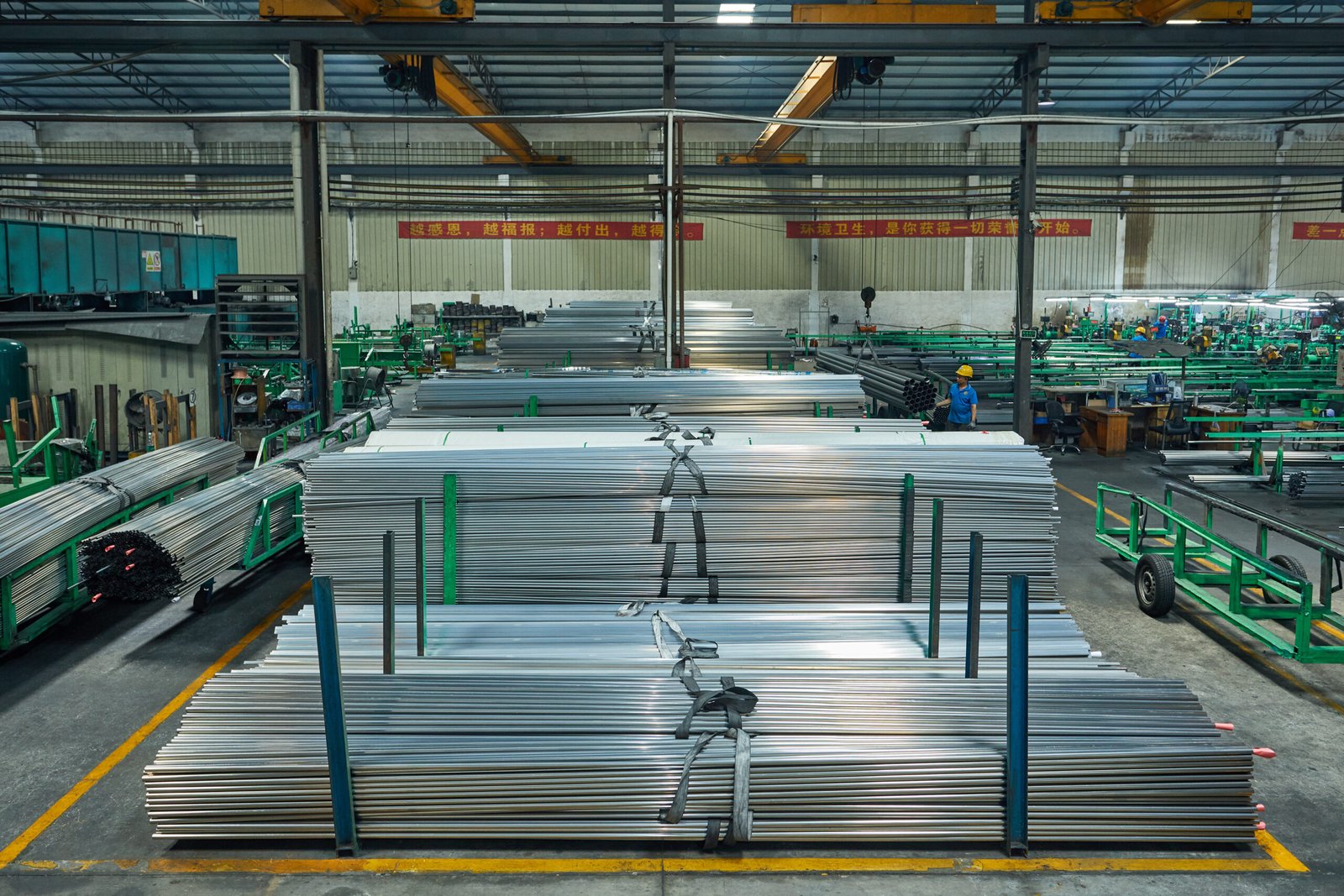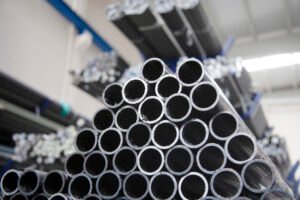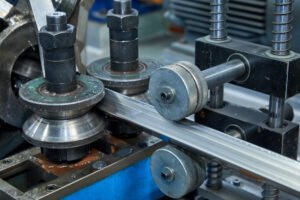5 Lean Strategies to Slash Scrap with Advanced Tube Manufacturing Machinery
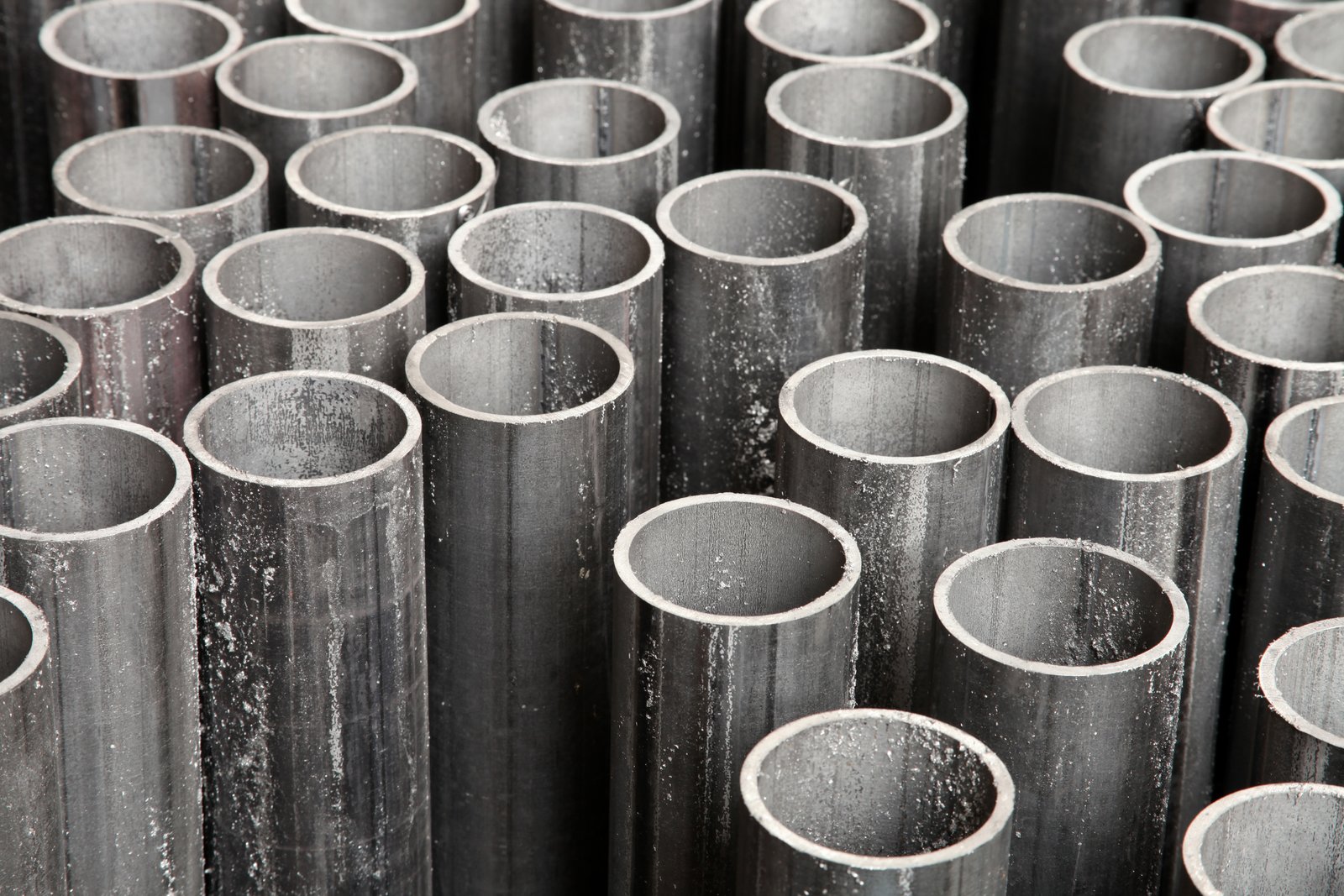
Are you constantly battling high scrap rates that eat away at your profit margins? It’s a frustrating cycle where valuable raw material is lost to defects, setup adjustments, and production errors, directly impacting your bottom line and ability to compete on price and quality.
Snippet paragraph: Slashing scrap in tube manufacturing involves a lean approach focused on precision, automation, and data-driven decisions. By leveraging advanced machinery with features like optimized settings, automated processes, and real-time monitoring, you can significantly reduce material waste, improve output, and boost overall profitability.
Reducing scrap isn't just a cost-saving measure; it's a fundamental shift towards operational excellence1. For many producers I've worked with, the journey from high-waste to high-efficiency production felt daunting at first. However, by breaking it down into manageable, technology-driven strategies, they transformed their operations. This isn't about working harder; it's about working smarter, using the right tools to achieve unparalleled precision and consistency. Let's explore these strategies in detail.
This transformation requires more than just a desire for less waste; it demands a critical look at the core of your production line. While traditional methods2 may offer some control, they often fall short in today's demanding market. The key lies in leveraging advanced manufacturing technology that is engineered for precision from the ground up. At XZS, we've spent over 15 years perfecting machinery that embeds lean principles into its very design. For example, a client in the automotive sector was struggling with an 8% scrap rate, a significant drain on their resources. By upgrading to one of our intelligent production lines, they slashed that figure to under 2%. This wasn't magic; it was the result of superior machine stability, precision controls, and the ability to repeat perfect setups every single time, turning theoretical lean concepts into tangible financial returns.
Step 1: How can optimizing machine settings reduce material waste in tube manufacturing?
Are your machine operators spending too much time on trial-and-error setups that generate coils of scrap? This initial waste is a significant yet preventable cost. The solution lies in leveraging machinery designed for rapid, repeatable, and precise configuration from the very first meter of material.
Optimizing machine settings, such as roller alignment, welding parameters, and cutting length, is crucial for waste reduction. Properly calibrated machinery ensures tubes meet strict dimensional and structural specifications from the start, minimizing defects like improper seams, ovality, and incorrect lengths that lead to scrap.
Moving beyond basic adjustments is where true efficiency gains are found. It’s one thing to get a single batch right, but it's another to ensure that level of quality is repeatable across different operators, shifts, and product specifications. The secret is embedding precision not just in the operator's skill, but in the core DNA of the machine itself. This involves a granular look at every component that shapes and welds the tube. For instance, the stability of the machine frame, the micro-adjustability of the rollers, and the intelligence of the welding controls all play a vital role. In my experience visiting countless tube mills, I’ve seen how seemingly minor misalignments or parameter drifts can compound into significant material losses over a production run. True optimization, therefore, is a systematic process supported by superior engineering, where the machine’s inherent accuracy provides a stable foundation for every adjustment, ensuring that once a setting is perfected, it can be reliably replicated time and time again.
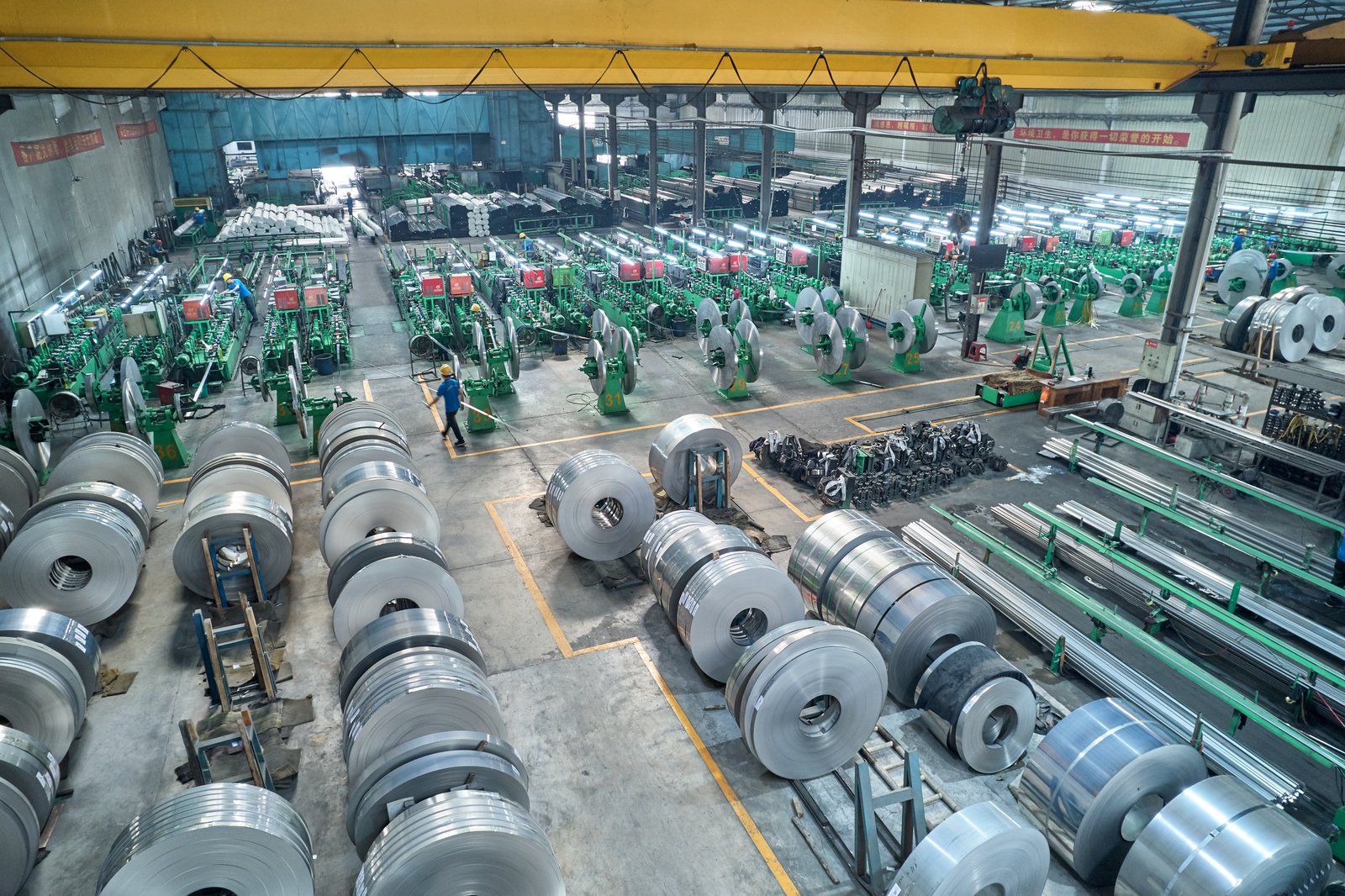
Strategy 1: Achieve First-Time-Right Forming with Precision Roller Tooling
The forming section is the heart of any tube mill, and it's often the primary source of preventable scrap. When roller pressure and alignment are inconsistent, it leads to a host of defects, from ovality and twisting to open seams, all of which render the product useless. Traditional machinery often relies on manual, experience-based adjustments, which can vary significantly between operators and shifts, leading to prolonged and wasteful setup periods. I recall a client in Brazil producing sanitary-ware tubes who struggled with this very issue. Their setup scrap alone accounted for nearly 4% of their material usage because achieving the perfect roundness and seam position was a constant battle of tweaks and re-tweaks.
The solution lies in a system built for absolute repeatability. Our intelligent production lines at XZS are constructed on robust, CNC-machined frames that guarantee foundational stability. Upon this base, the roller stations are designed for micro-fine adjustments, allowing operators to achieve and document precise settings. More importantly, our quick-change tooling systems ensure that these precision-engineered rollers can be swapped out and reset to a pre-validated configuration with minimal effort. This approach, which we've refined over 15 years, empowers producers to reduce setup time and associated scrap by over 70%. It transforms setup from an art into a science, ensuring the very first length of tube is a saleable product.
This precision is not just about the mechanics; it’s about the philosophy of control. By holding tolerances as tight as ≤ ±0.05 mm, our machinery eliminates the guesswork. The calibrated tooling and stable machine base mean that the optimal settings for a specific tube dimension and material grade can be saved and recalled through the PLC system. This ensures that a perfect run can be replicated weeks or months later with the exact same quality, effectively deskilling the most challenging part of the setup process and placing the control back into the hands of the production manager.
Strategy 2: Eliminate Weld Defects with Intelligent High-Frequency Welding
The welding stage is another critical point where material is frequently wasted. Too much heat can cause burn-through or excessive weld bead, while insufficient heat results in a weak or incomplete seam that will fail during pressure testing or subsequent processing. Both scenarios lead directly to the scrap pile. The challenge with conventional welders is maintaining a perfectly stable power output, especially during fluctuations in line speed or ambient factory conditions. For manufacturers of high-pressure tubes, such as for automotive heat exchangers, weld integrity is non-negotiable, and any deviation results in costly, 100% scrap of the affected material.
Our solution is an energy-saving, high-frequency solid-state welding system integrated directly with the mill's central PLC controller3. This system doesn't just produce heat; it intelligently manages energy delivery. The controller continuously monitors the mill's speed and the tube's position, making real-time micro-adjustments to the welding power to ensure a consistent, optimal thermal profile. This closed-loop control maintains weld integrity even during mill acceleration or deceleration, a common source of defects. As a result, our clients have virtually eliminated weld-related scrap, contributing to a material utilization rate of up to 98%.
Furthermore, this intelligent energy management provides significant efficiency benefits beyond scrap reduction. By delivering power precisely when and where it's needed, the system consumes considerably less energy than traditional vacuum tube welders4. This dual benefit of higher quality and lower operating costs is a core tenet of lean manufacturing. A typical client producing industrial stainless steel pipes could see a reduction in energy costs of up to 30%, which, combined with the savings from near-zero weld scrap, provides a powerful and rapid return on investment.
Strategy 3: Synchronize Cutting for Zero-Waste Length Control
The final step in primary tube manufacturing, the cutting process, can be a surprising source of hidden scrap. If the cutting system is not perfectly synchronized with the speed of the moving tube, it results in incorrect lengths. Short tubes are immediate scrap, while long tubes require secondary trimming, which creates waste and adds labor costs. In high-speed operations, even a millisecond of lag in the cutting activation can lead to unacceptable length deviations.
To counter this, our production lines utilize advanced flying cut-off saws that are seamlessly synchronized with the main mill drive via the central PLC and touch-screen interface5. The operator simply inputs the desired length, and the system takes care of the rest. An encoder constantly tracks the tube's position and speed, and the PLC calculates the precise moment to fire the saw blade to ensure every cut is identical and accurate. This level of automation guarantees that every piece falls within the specified length tolerance, eliminating end-of-line scrap.
Below is a comparison highlighting the impact of synchronized cutting systems on length accuracy and waste.
| Feature | Manual / Semi-Auto System | XZS Fully Automated System |
|---|---|---|
| Length Control | Operator-dependent timing | PLC-controlled, encoder-based |
| Typical Accuracy | ± 1.0 to 2.0 mm | ≤ ± 0.5 mm |
| Speed Fluctuation Impact | High risk of length deviation | Automatic compensation |
| Resulting Scrap Rate | 1-2% from incorrect lengths | < 0.1% from incorrect lengths |
| Secondary Operations | Frequent need for re-trimming | Re-trimming eliminated |
The financial impact of this precision is substantial. Consider a furniture manufacturer producing thousands of cut-to-length tubes daily. A 1% scrap rate from inaccurate cuts could mean hundreds of meters of wasted stainless steel every week. By implementing a fully synchronized cutting system, this waste is converted directly into profit. It’s a clear example of how investing in integrated, intelligent machinery delivers continuous returns by simply ensuring the job is done right the first time, every time.
Step 2: What role does automation play in minimizing scrap during tube production?
Are operator inconsistencies and manual errors leading to unpredictable quality and excessive scrap? Relying on human intervention for critical processes introduces variability. Automation is the key to creating a stable, repeatable, and highly efficient production environment where waste is systematically engineered out of the process.
Automation plays a pivotal role by removing human variability from critical tasks like machine setup, weld control, and cutting. By using PLC-controlled systems and automated welding technology for these functions, manufacturers can ensure consistent adherence to specifications, which dramatically reduces errors and subsequent material scrap.
Embracing automation goes far beyond simply replacing a few manual tasks. It represents a strategic shift in manufacturing philosophy, moving from a reactive "inspect and correct6" model to a proactive "predict and prevent" one. When processes are automated, they become measurable, controllable, and optimizable in a way that is impossible with manual operations. This opens the door to a higher level of process control where data from one automated system can inform and adjust another in real-time. For example, an automated in-line gauge can feed data back to the roller controls to correct a dimensional drift before it results in out-of-spec products. This interconnected ecosystem is where the most significant gains in scrap reduction are realized. It's not about individual robots or controllers; it's about creating a single, cohesive, intelligent production line that self-regulates to maintain peak efficiency and quality, minimizing the potential for waste at every single stage of the tube's creation.
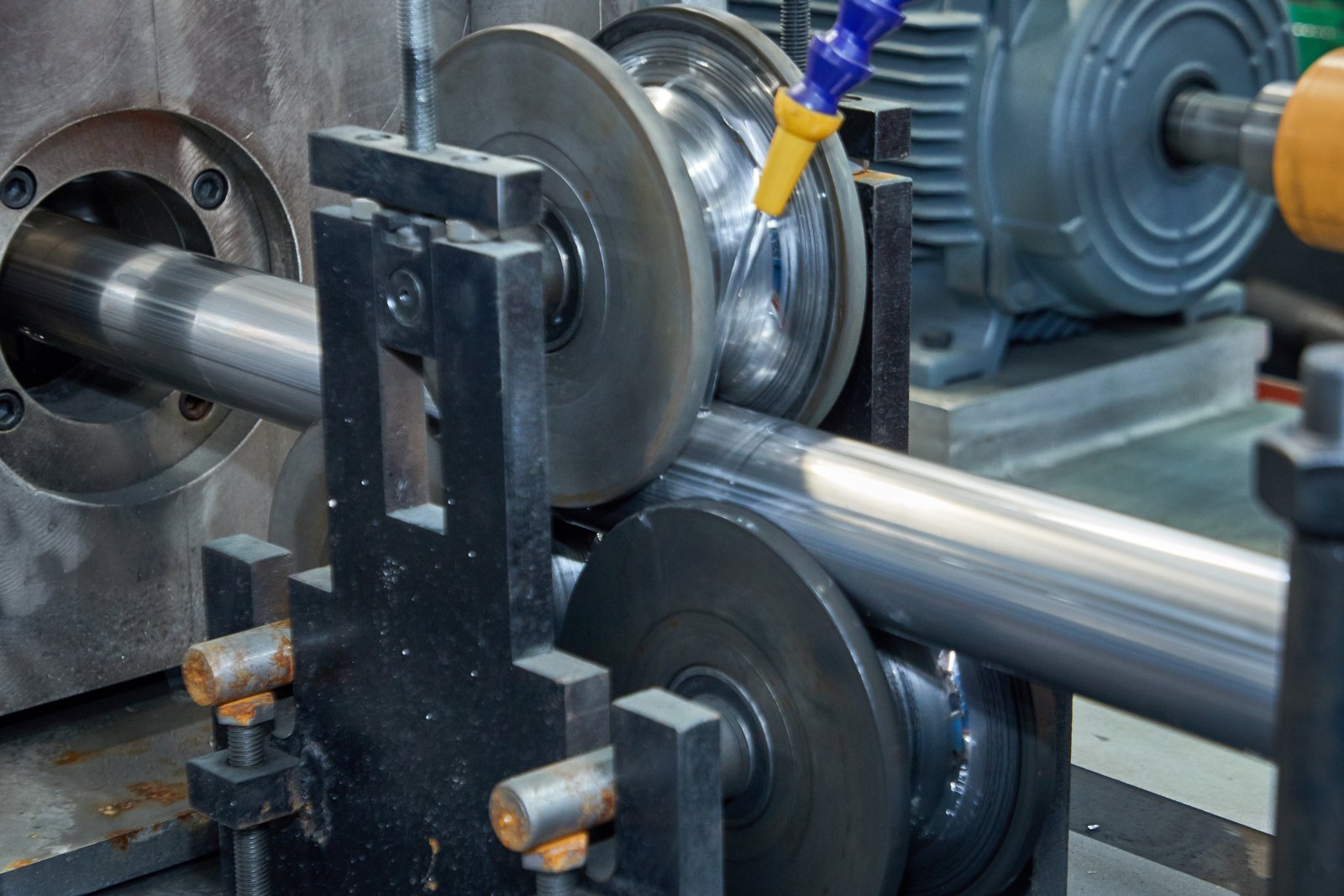
Strategy 4: Implement Automated Setup and Quick-Change Tooling
One of the most significant sources of scrap in any tube mill is the setup and changeover process7 between different product sizes. Manual changeovers are time-consuming and fraught with potential for error. Operators must adjust each roller stand individually, relying on experience and feel to achieve the correct alignment. This often results in a lengthy trial-and-error period, consuming valuable material and labor before the first good pipe is produced. I worked with an industrial equipment distributor whose end-users frequently complained about this exact problem, as it severely hampered their ability to handle smaller, more varied orders profitably.
Automation directly confronts this challenge through systems like our fully automated PLC + touch-screen control combined with quick-change tooling. Instead of manual adjustments, a modern production line stores the precise settings for each job—roller positions, welder power, mill speed—in its memory. When it's time to change from a 50mm to a 76mm tube, the operator simply selects the new job from the touch screen. The system then automatically adjusts the powered roller stations to the pre-programmed positions. This, combined with a cassette-style quick-change system for the tooling, can reduce changeover times from several hours to under 60 minutes.
The impact on scrap is twofold. First, the drastic reduction in setup time means less material is wasted during the initial trial runs. Because the machine returns to a known, perfect state, the process is right from the first attempt. Second, it eliminates the variability between operators. The "perfect" setup achieved by your most skilled technician is now the standard for every shift, every day. This consistency is the bedrock of low-scrap manufacturing and allows businesses like the aforementioned client to confidently take on a wider range of jobs without fearing the associated setup waste.
Strategy 5: Utilize Robotic Handling and Packaging to Prevent Damage
Material waste doesn't only occur during forming and welding; a surprising amount of finished product becomes scrap due to post-production damage. Manually handling long, heavy, or thin-walled tubes can easily lead to scratches, dents, and bending. This is especially true for high-value products like polished decorative tubes or precision automotive components, where even a minor surface imperfection can lead to rejection. A furniture fabricator I know used to report a consistent 1-2% loss purely from handling damage between the cutting station and the packing area.
Integrating robotic handling systems for tube manufacturing8 at the end of the line is a powerful lean strategy to eliminate this form of waste. Once a tube is cut, a robotic arm can gently pick it up, transport it, and stack it into a crate or onto a pallet with a level of precision and care that is impossible to replicate manually on a consistent basis. These systems can be programmed to handle different tube sizes and weights, ensuring that each piece is supported correctly to prevent bending and spaced appropriately to avoid surface-to-surface contact and scratching.
For manufacturers in industries where cosmetic appearance is paramount, such as sanitary-ware or high-end furniture, this investment is critical. The robot doesn't get tired or careless at the end of a long shift. It performs the exact same perfect movement every single time. By automating this final step, you protect the value that has been added throughout the entire manufacturing process. The 1-2% loss from handling damage is converted directly back into saleable inventory, often justifying the investment in robotics within a very short period.
Strategy 6: Employ Closed-Loop Control for Proactive Quality Assurance
Traditional quality control is reactive. You produce a batch of tubes, take a sample, measure it, and if it's out of spec, you scrap the bad material and adjust the machine. The core issue here is that the scrap has already been produced. The lean solution is to implement closed-loop feedback systems9 that prevent the machine from producing scrap in the first place. This is a pinnacle of automation, where the line essentially monitors and corrects itself in real-time.
This is achieved by integrating in-line, non-contact measurement devices (like laser micrometers) directly into the production line. These devices continuously measure the tube's diameter, ovality, and wall thickness as it is being produced. This data is fed back to the PLC controller in a continuous stream. If the system detects a slight drift—for example, the diameter is increasing by a few hundredths of a millimeter—it doesn't wait for an operator to notice. The PLC instantly sends a command to the forming rollers to make a micro-adjustment, bringing the tube back into the exact center of its tolerance band.
Here is a table illustrating the fundamental difference between reactive and proactive quality control.
| Aspect | Reactive QC (Manual/Offline) | Proactive QC (Automated Closed-Loop) |
|---|---|---|
| Data Collection | Periodic sampling of finished product | Real-time, continuous measurement of product in-process |
| Response to Deviation | Operator adjusts machine after scrap is found | System self-corrects before scrap is produced |
| Scrap Generation | Batches of scrap are common | Scrap is minimized to near-zero levels |
| Process Capability (Cpk) | Typically lower; process drifts | Significantly higher; process stays centered |
| Labor Requirement | Requires constant operator monitoring and intervention | Frees operator for higher-level tasks |
This proactive, self-regulating approach is the hallmark of a truly intelligent production line. It ensures that every meter of tube produced is within spec, maximizing material utilization and pushing output rates higher. For producers of high-specification tubes for industries like oil and gas or automotive, where tolerances are non-negotiable, this automated quality assurance is not a luxury; it's an essential component for competitive, zero-defect manufacturing.
Step 3: How can regular maintenance of machinery contribute to less scrap generation?
Is gradual machine wear silently increasing your scrap rates? Seemingly minor issues like worn bearings or misaligned rollers can degrade performance over time, leading to inconsistent quality and wasted material. A proactive maintenance strategy is essential to keep your machinery operating at its peak precision.
Regular maintenance prevents the gradual degradation of machine components that leads to production inaccuracies. By servicing parts like rollers, bearings, and welding contacts, you ensure the mill holds its tight tolerances, preventing defects and reducing the amount of material scrapped due to machine-related inconsistencies.
Shifting from a "fix it when it breaks" mindset to a culture of preventive and predictive maintenance is fundamental to lean manufacturing strategies10. Reactive maintenance doesn't just result in downtime; the period leading up to the failure is often marked by a slow decline in quality and a corresponding rise in scrap. A worn-out bearing doesn't fail catastrophically overnight; it first introduces subtle vibrations and misalignments that cause dimensional defects. By the time the component breaks, you may have produced hundreds of meters of non-conforming tube. Proactive maintenance, supported by a robust machine design that simplifies service, allows you to address these issues before they ever impact production. It's about maintaining the inherent precision that was engineered into the machine from day one, ensuring it consistently delivers the quality and efficiency you expect, thereby protecting your material, your time, and your profit margins.

Strategy 7: Institute a Preventive Maintenance Schedule
The most straightforward yet highly effective strategy is the implementation of a rigorous preventive maintenance (PM) program. This involves scheduling regular inspections, lubrication, cleaning, and replacement of wear parts based on the manufacturer's recommendations11 and operational data. The goal is to address potential issues before they escalate into failures that produce scrap. For a tube mill, this means regularly checking the condition of forming and sizing rollers, the alignment of weld boxes, the health of bearings and gearboxes, and the cleanliness of welding contacts. A small amount of play in a worn roller bearing, for instance, can translate into significant ovality issues in the finished tube.
In my role at XZS, we design our machinery with maintenance in mind. We provide clients with detailed PM schedules and ensure that service points are easily accessible. One client, an HVAC pipeline contractor in the Middle East, saw their scrap rate creep up by 3% over two years. An audit revealed that their maintenance was purely reactive. After we helped them implement a simple weekly and monthly PM checklist, their scrap rate dropped back to its original low level within a month. The discipline of the schedule eliminated the slow, unnoticed degradation of machine accuracy.
A well-documented PM program also creates a valuable historical record. By tracking component wear and replacement cycles, you can begin to predict failures and optimize your spare parts inventory. This data-driven approach removes guesswork and ensures that maintenance activities are performed at the optimal time—not too early (wasting component life) and never too late (after scrap has been produced). It's a foundational practice for any serious manufacturing operation.
Strategy 8: Leverage Predictive Maintenance (PdM) with IoT Sensors
Preventive maintenance is good, but predictive maintenance (PdM) using IoT sensors12 is the next evolution in lean strategy. Instead of relying on a fixed schedule, PdM uses technology to monitor the actual condition of the machinery in real-time to predict when maintenance will be needed. This is achieved by embedding IoT (Internet of Things) sensors on critical machine components. These sensors can monitor variables like vibration, temperature, and electrical current. The data is then analyzed by software to detect patterns that indicate impending failure.
For example, a sensor on a gearbox bearing can detect a subtle increase in vibration long before a human operator could ever notice it. The system would then flag this specific bearing for inspection or replacement at the next planned stop, preventing a catastrophic failure that could not only produce scrap but also cause extensive damage and downtime. Similarly, monitoring the temperature of the high-frequency welder's components can signal a cooling system issue before it leads to overheating and inconsistent weld quality.
This approach offers unparalleled efficiency. Maintenance is only performed when it is actually necessary, maximizing the life of components and minimizing maintenance labor. At XZS, we are increasingly integrating sensor readiness into our smart factory production lines, allowing our clients to adopt a PdM strategy. This empowers them to move beyond preventing failures to actively predicting them, creating a supremely reliable and low-waste production environment. It’s the ultimate defense against machine-related scrap.
Strategy 9: Train Operators in Maintenance and First-Line Checks
An often-overlooked strategy is to empower your machine operators by training them in basic maintenance and daily inspection routines, a concept known as Autonomous Maintenance13. Your operators are the ones who interact with the machinery all day, every day. They are in the best position to notice small changes in sound, feel, or performance that might signal an emerging problem. By training them on what to look and listen for, you create an engaged and proactive first line of defense against scrap-producing issues.
This training should include simple but critical tasks: how to properly clean rollers and weld areas, how to check for fluid leaks, how to verify the tension of belts, and how to spot early signs of wear on tooling. This doesn't replace the need for skilled maintenance technicians, but it complements their work perfectly. When an operator can identify and report a slight misalignment or a worn guide, the issue can be corrected during a short planned stop before it ever has the chance to generate out-of-spec tubes.
We encourage our clients to build this culture of operator ownership. A simple checklist at the start of each shift can work wonders. The table below outlines a sample daily operator check.
| Check Area | Task | Purpose |
|---|---|---|
| Forming Section | Visually inspect rollers for debris or damage. | Prevents surface marks on tubes. |
| Welding Unit | Check impedance coil for signs of arcing or wear. | Ensures consistent weld power and quality. |
| Cooling System | Verify coolant flow and temperature gauges. | Prevents overheating and weld defects. |
| Cutting Unit | Inspect saw blade for chips or dullness. | Guarantees a clean, precise cut and prevents burrs. |
| General | Listen for unusual noises (grinding, whining). | Early detection of bearing or gear issues. |
By making operators partners in the maintenance process, you foster a sense of pride and responsibility. They are no longer just machine runners; they are guardians of quality. This cultural shift, combined with robust preventive and predictive systems, creates a multi-layered defense that makes scrap generation from machine degradation a thing of the past.
Step 4: What impact does precision measurement tools have on scrap reduction?
Are you relying on manual calipers and visual checks to validate product quality? These traditional methods are slow and prone to error, often allowing entire batches of bad material to be produced before a problem is even detected. Precision measurement tools are your eyes, ensuring quality is maintained in real-time.
Precision measurement tools, such as laser micrometers and eddy current testers, provide real-time, non-contact measurement of tube dimensions and integrity. This allows for immediate detection of deviations from spec, enabling instant corrections that prevent the mass production of scrap material.
The integration of advanced measurement technology14 fundamentally changes the quality control paradigm. It shifts the process from a historical review of what you’ve made to a live view of what you’re making. This is a critical distinction. With manual, offline measurement, there's always a lag between production and detection. During that lag, you could be producing thousands of feet of scrap. In-line, automated measurement eliminates that lag entirely. Imagine being able to see the tube's diameter, wall thickness, and weld integrity on a screen, updated several times per second. This isn't just data; it's actionable intelligence. It allows the system, or the operator, to make tiny, proactive adjustments to keep the process perfectly centered on its target, ensuring that every foot of tube is identical and meets the required specifications. This level of insight and control is simply unattainable with traditional methods and is a cornerstone of modern, low-waste manufacturing.
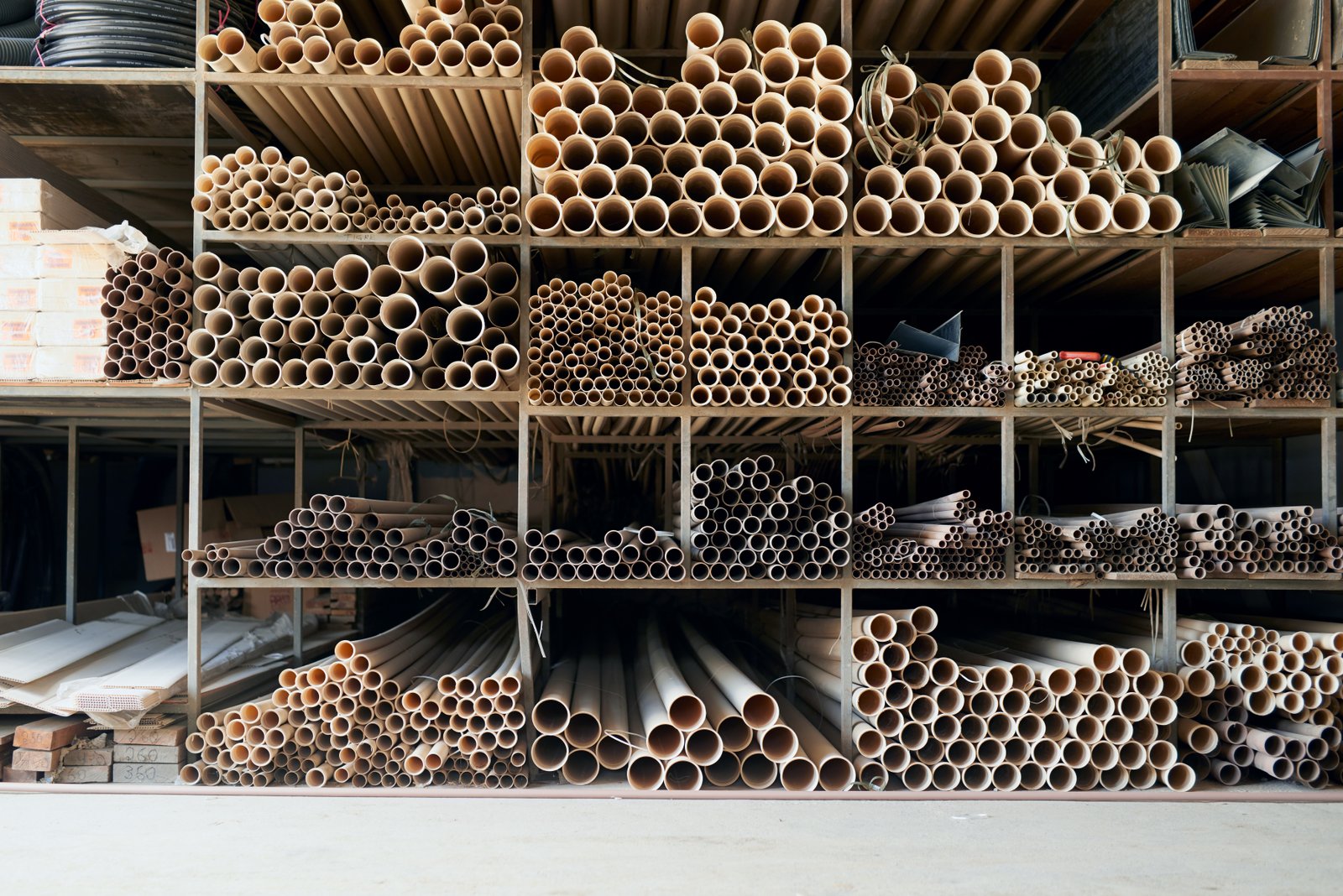
Strategy 10: Implement In-Line Laser Micrometers for Diameter Control
The outside diameter (OD) is one of the most critical specifications for any tube. For components that need to fit precisely with other parts, like in automotive or furniture applications, even a small deviation can lead to rejection. The traditional method of checking the OD involves an operator periodically taking a tube off the line and measuring it with manual calipers. This method is slow, operator-dependent, and samples only a tiny fraction of the total production, leaving large gaps where out-of-spec material can be produced unnoticed.
The lean strategy to overcome this is the implementation of an in-line, dual-axis laser micrometer. This device is mounted directly on the production line after the sizing section and uses laser beams to measure the tube's diameter continuously from two angles as it passes through. It can take thousands of readings per second with an accuracy often better than 0.001mm. This data is displayed in real-time and can be used to create a statistical process control (SPC) chart15, showing not just the current diameter but also the trend.
I have seen the transformative impact of this firsthand. A client producing precision stainless steel tubing for medical devices was struggling with a high rejection rate from their customers due to inconsistent OD. After integrating one of our tube mill lines equipped with a laser micrometer, they were able to see their process drift in real-time. This allowed them to fine-tune their roller settings with incredible accuracy. Furthermore, by feeding the laser data back into the PLC, they created a closed-loop system that automatically adjusted the rollers to maintain a perfectly consistent OD. Their customer rejection rate dropped to virtually zero within three months, saving them a fortune in scrapped material and freight costs.
Enhancing Quality with Eddy Current and Ultrasonic Weld Inspection
For many industrial applications, especially those involving pressure or structural loads, the integrity of the weld seam is just as important as the tube's dimensions. A microscopic flaw, crack, or pinhole in the weld can lead to catastrophic failure in the final application. Visually inspecting the weld is unreliable, and destructive testing (like flare or crush tests) only validates a small sample while destroying the product. To ensure 100% weld quality without creating waste, advanced non-destructive testing (NDT) methods16 are essential.
The two leading in-line NDT technologies for tube mills are Eddy Current Testing (ECT) and Ultrasonic Testing (UT). An ECT system uses an electromagnetic coil that surrounds the tube. It induces eddy currents into the material, and any flaw in the weld will disrupt these currents, which is instantly detected by the system. It is excellent for finding surface and near-surface defects at high production speeds. UT, on the other hand, uses high-frequency sound waves. A transducer sends a pulse of sound into the weld, and the system analyzes the returning echo. A flaw will change the echo's pattern, pinpointing its location and size. UT is particularly effective at finding internal defects within the weld body.
By installing an in-line ECT or UT system right after the welder, you get immediate feedback on weld quality. If a flaw is detected, the system can trigger an alarm and even activate a paint-marking device to identify the exact location of the defect on the tube. This prevents the flawed tube from being cut, bundled, and shipped. For a manufacturer of oil and gas pipelines, this isn't just about saving scrap; it's about safety, compliance, and protecting their reputation. It provides documented proof that every inch of their product has been inspected and meets industry standards.
The Power of Integrated Data and Statistical Process Control (SPC)
Having advanced measurement tools is powerful, but their ultimate value is realized when the data they generate is integrated and used to control the entire process. This is the essence of Statistical Process Control (SPC)17. Instead of just seeing a single measurement, SPC software collects data from your laser micrometer, your NDT system, and other sensors, and analyzes it to show you the health and capability of your entire production process. It tells you not just if you are in spec, but how well you are in spec.
This data allows you to move beyond simple pass/fail decisions. By analyzing trends, you can identify when a process is beginning to drift long before it goes out of tolerance. For example, an SPC chart might show that the average OD is slowly increasing over the course of a day, even though it's still within the acceptable range. This could indicate tooling wear or a gradual change in material properties. This insight allows you to make a proactive adjustment, re-centering your process and preventing future scrap.
Here’s a simple table showing how data transforms quality control:
| Data Point | Simple Measurement (Go/No-Go) | Integrated SPC (Process Control) |
|---|---|---|
| OD Reading | "Is this tube 50mm?" | "The process average is 50.01mm with a Cpk of 1.67. The process is stable and capable." |
| Weld Flaw | "Scrap this tube." | "Flaw detected. Logged data shows a 5% spike in weld power 2 seconds prior. Investigate welder stability." |
| Data Usage | Reactive sorting of good vs. bad parts. | Proactive analysis to improve process stability and prevent defects. |
| Outcome | High inspection cost, moderate scrap. | Minimal inspection cost, near-zero scrap. |
At XZS, we design our PLC control systems to be the central hub for this data. They can interface with a wide array of measurement devices and present the information in a clear, actionable format on the main touch screen. This transforms the tube mill from a collection of individual machines into a single, intelligent, data-driven system focused on one goal: producing perfect tubes with zero waste.
Step 5: How does real-time monitoring and data analysis help decrease waste in manufacturing?
Are you making critical production decisions based on outdated information or guesswork? Without a live view of your operations, you're blind to the small inefficiencies that accumulate into significant waste. Real-time monitoring and data analysis provide the clarity needed to optimize performance and slash scrap.
Real-time monitoring provides immediate insight into machine performance and production quality. By analyzing this live data, manufacturers can instantly identify deviations, pinpoint the root causes of scrap, and make data-driven adjustments to optimize processes and prevent waste before it accumulates.
The leap from traditional manufacturing to a smart, lean operation is paved with data. Real-time monitoring is like switching on the lights in a dark factory; suddenly, you can see everything. You see the mill's exact speed, the welder's energy consumption, the product dimensions, and the overall equipment effectiveness (OEE). But seeing the data is only the first step. The true power comes from analysis—connecting the dots between different data points to understand the why behind the numbers. Why did the scrap rate spike on the night shift? Data analysis might reveal a correlation with a drop in welding power. Why is one material grade producing more waste than another? Analysis could pinpoint a need for a different roller setup. This continuous loop of monitoring, analyzing, and optimizing is what drives relentless improvement and turns your production line into a highly efficient, waste-minimizing asset.
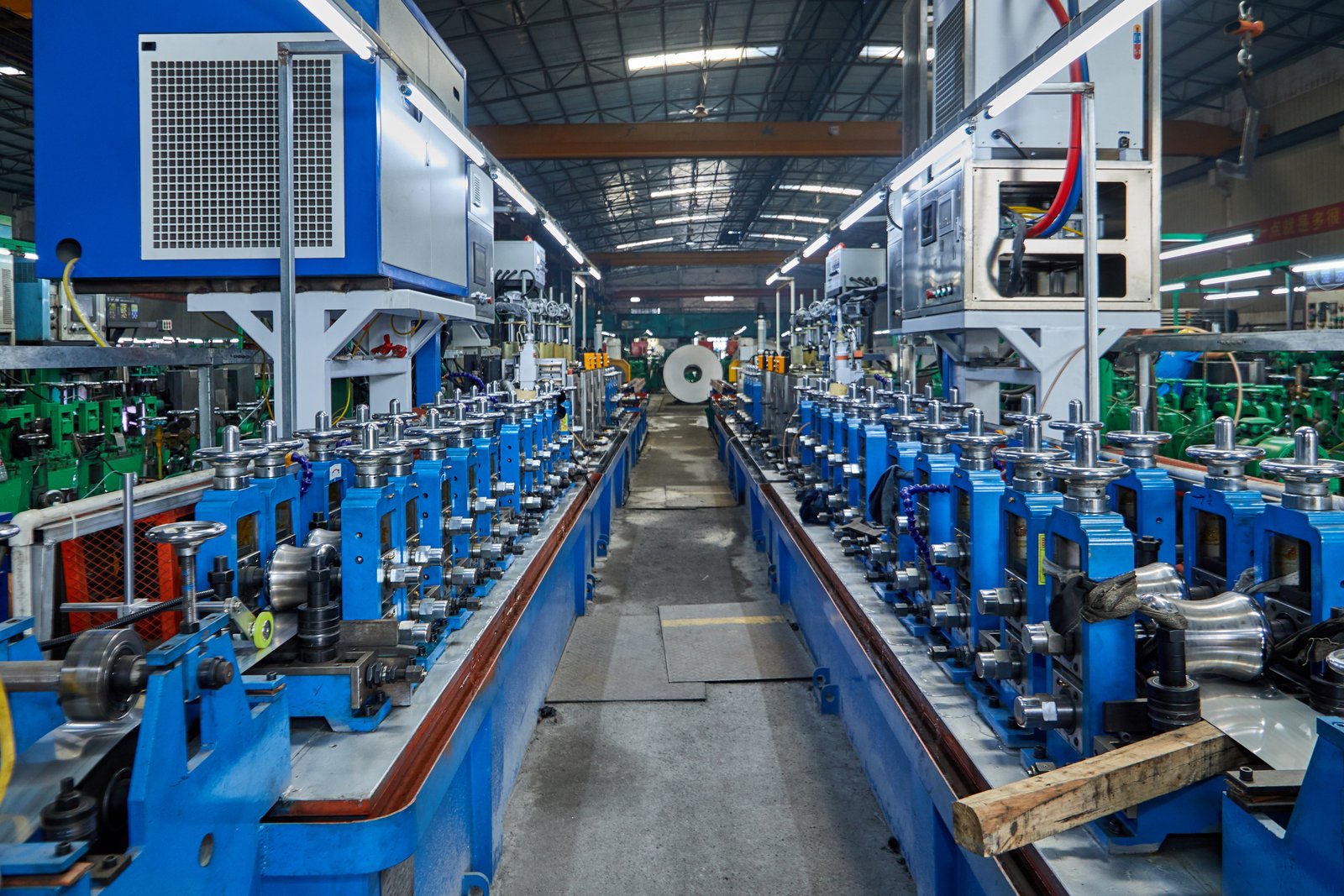
Centralizing Operations with a Master PLC Control System
In a conventional tube mill, various components often operate as independent islands. The mill has its own controls, the welder has another, and the cutter a third. This fragmented approach makes it impossible to get a holistic view of the operation and leads to inefficiencies and scrap. A core strategy for waste reduction is to centralize control of the entire production line into a single, master PLC (Programmable Logic Controller) system, typically managed through an intuitive touch-screen interface.
This integrated system acts as the brain of the operation. From one central screen, the operator can monitor and control every critical parameter: the speed of the forming section, the power output of the welder, the synchronization of the flying cut-off, and the data from in-line quality sensors. When you need to increase the line speed, the PLC automatically adjusts the welder power and cutter timing in perfect harmony. This eliminates the manual coordination errors that frequently lead to defects and scrap during speed changes.
I've seen the direct impact of this integration with our clients. A producer of large-diameter industrial pipes used to struggle with weld quality issues at the beginning and end of each run due to poor synchronization between the mill and welder. After upgrading to an XZS heavy-duty tube mill with our integrated PLC, these issues vanished. The system's ability to manage the entire line as a single entity ensured seamless operation from start to finish. This not only cut their scrap by 40% but also allowed them to run the mill at a consistently higher speed, boosting overall productivity.
Tracking Overall Equipment Effectiveness (OEE) to Pinpoint Inefficiencies
You can't improve what you don't measure. Overall Equipment Effectiveness (OEE) is a critical metric in lean manufacturing that provides a comprehensive view of your production efficiency. It is calculated by multiplying three factors: Availability (runtime vs. planned time), Performance (actual speed vs. potential speed), and Quality (good parts vs. total parts). A perfect OEE score of 100% means you are producing only good parts, as fast as possible, with no stop time. The "Quality" component of OEE is a direct measure of your scrap rate.
A modern, data-enabled tube mill can automatically track these variables. The PLC logs all stop times, tracks the production speed against the ideal rate, and counts the number of good pieces versus rejected pieces (identified by in-line sensors). This data is then presented in a clear OEE dashboard. This allows managers to move beyond a vague feeling that "we're producing too much scrap" to a precise understanding of their losses.
For example, the OEE data might reveal that your Quality score is consistently 95%, meaning 5% of your production is scrap. The system can then help you drill down further. By correlating the scrap events with other data, you might find that 80% of that scrap occurs during the first 30 minutes of a new shift. This points directly to a setup or changeover issue, not a random machine fault. This level of insight is invaluable, allowing you to focus your improvement efforts where they will have the greatest impact.
Using Historical Data for Continuous Improvement and Root Cause Analysis
Real-time data is for immediate control, but historical data is for long-term improvement. A smart production line logs all critical process data and events. This creates an invaluable digital record of your entire production history. When a quality issue does arise, you can use this data to perform a thorough root cause analysis instead of relying on speculation.
Imagine a customer reports a weld failure on a tube produced three weeks ago. With a traditional system, finding the cause would be nearly impossible. With a data-logging system, you can pull up the record for that exact production run. You can see the specific weld parameters used, the mill speed, the NDT sensor readings, and any alarms that occurred. Perhaps the data reveals a brief dip in welding voltage at that precise moment. You've found your root cause. Now you can take corrective action, such as investigating the power supply to the welder, to ensure it never happens again.
This ability to forensically analyze past production is a game-changer. It allows you to learn from every mistake and systematically eliminate the root causes of scrap from your process. Below is a table that illustrates the power of data logging for problem-solving.
| Scenario | Without Data Logging | With Data Logging |
|---|---|---|
| Intermittent Defect | Problem is "random." Operators try different fixes with no clear result. | Data analysis shows the defect correlates with a specific batch of raw material. |
| High Scrap on a Shift | Blame is placed on the operator. Morale suffers. | Data shows machine performance degraded over the shift, pointing to a need for maintenance. |
| Customer Complaint | Unable to verify production conditions. A costly recall or refund may be necessary. | Can provide customer with a detailed report showing the part was produced within all specs. |
By leveraging a continuous cycle of real-time monitoring, OEE tracking, and historical data analysis, you create a truly intelligent manufacturing environment. It's a system that not only minimizes waste in the present but also learns and improves to prevent waste in the future.
Conclusion
Embracing these ten lean strategies, powered by advanced machinery, is the definitive path to slashing scrap. By focusing on precision settings, automation, proactive maintenance, and data-driven analysis, you can transform your tube manufacturing operation, drastically cutting waste and boosting your bottom line and market competitiveness.
-
Discover frameworks and best practices to improve process efficiency and reduce manufacturing waste. ↩
-
Understand why older processes may fall short in today’s competitive manufacturing environment. ↩
-
Explore how integrated welding technologies improve consistency and reduce waste in pipe production. ↩
-
Compare energy usage, maintenance, and product quality of different tube welding technologies. ↩
-
Learn how synchronized automation ensures perfect cuts and minimizes material scrap. ↩
-
Understand the evolution from reactive to predictive quality control in manufacturing processes ↩
-
Discover how automation minimizes material waste during production changeovers ↩
-
See how robotic systems prevent damage and waste post-production in tube manufacturing ↩
-
Learn how closed-loop control technology leads to zero-defect and proactive tube manufacturing ↩
-
Learn why maintenance is essential for lean manufacturing and reducing waste in production ↩
-
Get industry-standard PM guidelines to ensure long-term equipment reliability and performance ↩
-
Find out how IoT sensor data can reduce unplanned downtime and scrap rates in factories ↩
-
Discover best practices for training operators in first-line maintenance and daily checksn ↩
-
Discover how automation eliminates quality gaps and reduces defective output in real-world production. ↩
-
Understand how SPC charts visualize process trends and help manufacturers proactively reduce scrap. ↩
-
Get a technical overview of ECT and UT solutions for 100% weld inspection. ↩
-
See real examples of how SPC data integration improves process stability and product quality. ↩
